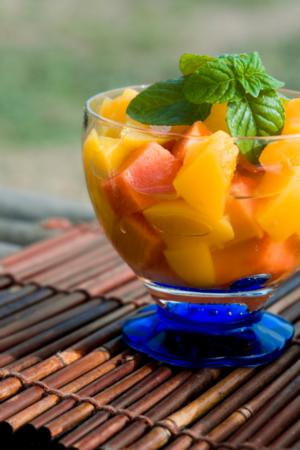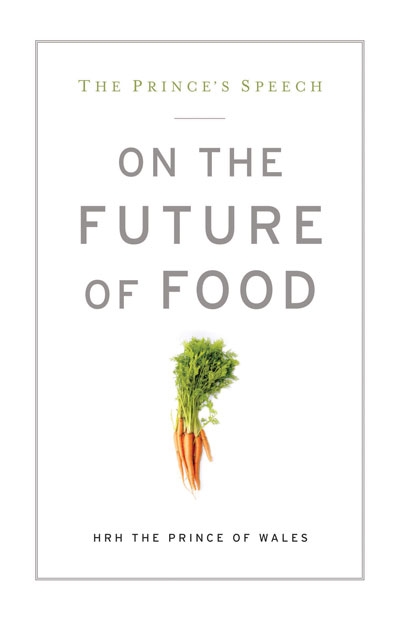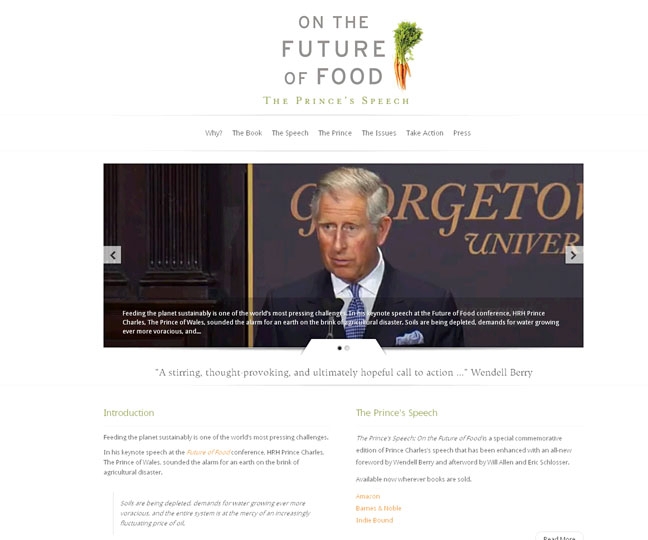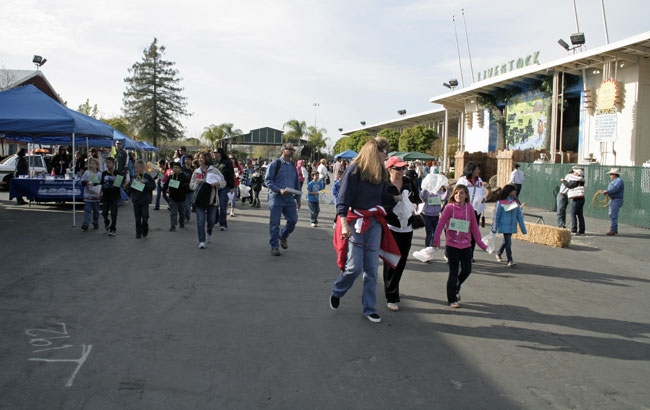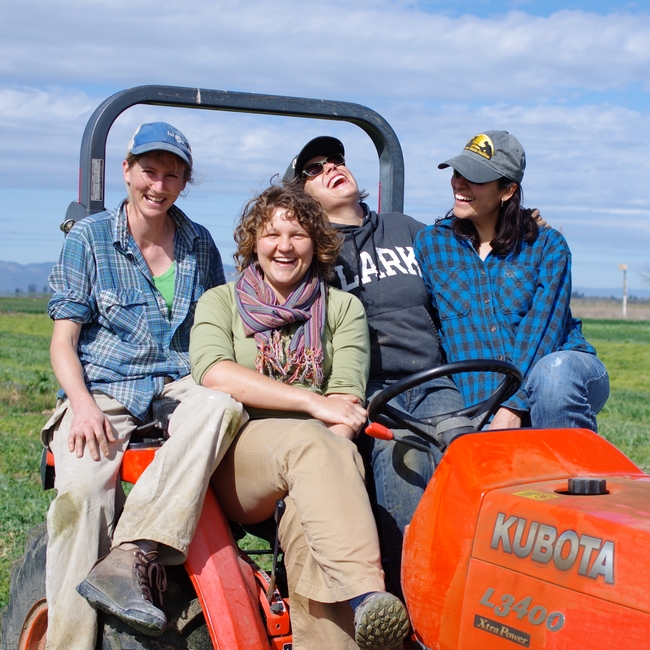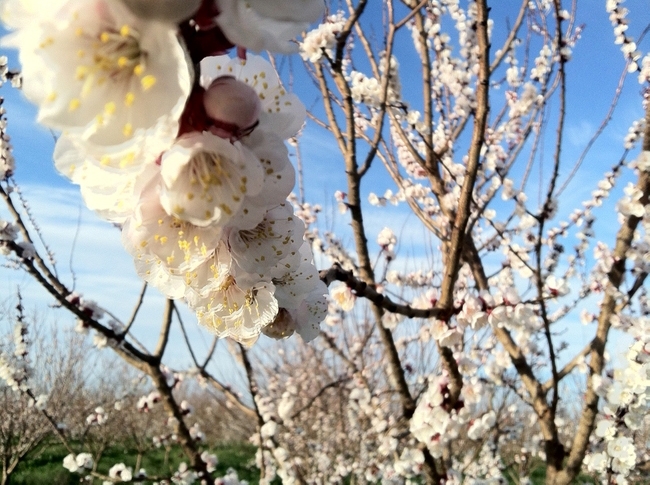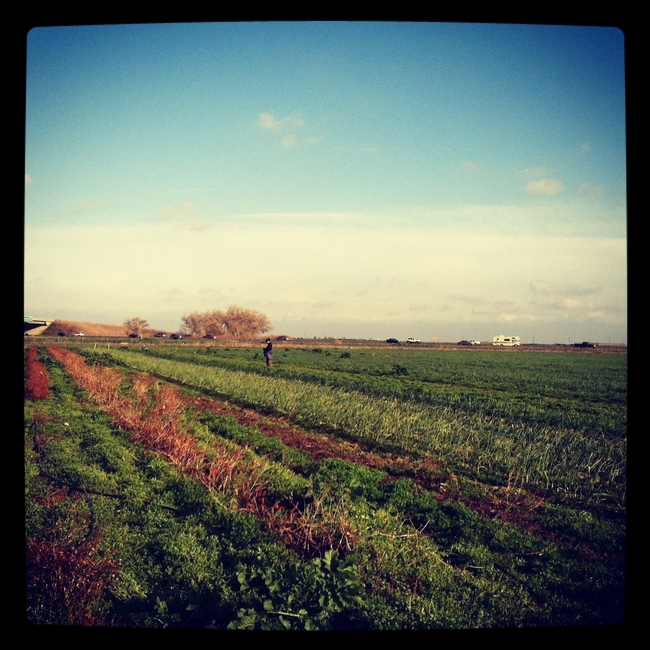UC Food Blog
Ode to Breakfast!
Breakfast has to be the greatest meal of the day by far! I might be biased because it includes coffee – in my opinion the greatest beverage in the world - but that’s a subject for another day.
There are so many benefits to breakfast. The options of what to eat are endless - plus breakfast wakes you up and gets you energized for your day! It makes me sad that most people won’t take the time to fall in love with breakfast.
The usual excuses are always present:
- “I’m on a diet, so I’m skipping breakfast!”
- “I don’t have time.”
- “I’ll grab something at insert fast food/coffee house chain here it’s easier.”
- “I can’t eat breakfast, it upsets my stomach.”
Come on people wake up and smell the oatmeal and eggs!
Breakfast can be the most elaborate meal to make OR the easiest and fastest. Here are some tips to help beat the excuses and rediscover breakfast for the health of you and your family!
Skipping a meal will help you lose weight—true or false? FALSE! Breakfast literally means to “break-the-fast,” after sleeping all night. It’s important to eat to get your metabolism going for the day! Watching your weight? Try taking the time to create these meals that contain all 5 MyPlate food groups:
- Make an omelet or scrambled eggs and toss in your f avorite chopped veggies. Cut the fat by using just the egg whites. Add some low-fat cheese, and eat with whole wheat toast and a sliced apple.
- Make your own power smoothie: blend an apple, banana, some berries, a carrot and zucchini with low-fat yogurt and some orange juice. Serve with half of a whole wheat bagel topped with peanut butter.
- Make a breakfast burrito! Warm a whole wheat tortilla, cook up your favorite meat, scrambled eggs, and toss in some black beans. Add veggies, salsa, and low-fat cheese.
Breakfast takes too long to make-true or false? FALSE! So you would rather sleep in an extra 15 minutes than take the time to make a hot breakfast?
DO get that beauty rest!
DON’T skip breakfast or spend the money on a less healthy fast food breakfast.
Try these tips to have a healthy breakfast on the go:
- Take a whole wheat tortilla and spread with peanut butter; add granola and your favorite fruit! Roll it up and go. Take a glass of low-fat milk with you to get some dairy.
- Broil half of a whole wheat bagel with low-fat cheese; eat on the go with a hardboiled egg, and a banana.
- Prep your breakfast burrito the night before, so it’s ready to grab on your way out the door.
Breakfast isn’t for everyone-true or false? FALSE! So you tend to have a bit of a queasy stomach in the morning? Here are some tips to overcome the queasy and still eat breakfast:
- Take your time, don’t rush to eat breakfast. Set aside time to relax and enjoy your meal.
- Take your food with you to work or school, wait until your stomach calms down and then eat!
- Queasiness tends to be the effect of an empty stomach, so it’s even more important to eat breakfast.
When you eat a healthy breakfast you are more likely to focus and pay better attention to work, school or home activities.
Growing Solutions in Urban Communities
On Saturday, March 31, Angelenos celebrated the Mayor's "Good Food Day of Service." Los Angeles Mayor Villaraigosa, the Los Angeles Food Policy Council, and numerous community partners organized this city-wide event to highlight the importance of healthy food and celebrate the legacy of César Chávez. There were 100 participating sites around the city, all featuring community service focused on healthy food access.
I participated at the Glassell Park Community Garden in Northeast Los Angeles by giving several short workshops on container gardening. I had not visited this garden before, and found its history especially interesting. Wedged between apartment buildings and houses, the garden just got started last July, yet already seems to be a hub of community activity. Previously, it was the site of a house that was a notorious drug distribution center. The story of this site was featured in the Los Angeles Times last April. The house was demolished and the lot donated to the City. The area's city councilman believed that a community garden on the site could help the neighborhood heal from years of exposure to criminal activity, and enlisted the partners necessary to make it happen.
In this situation, a community garden was viewed as part of a solution to an urban problem. The notion that growing gardens can help solve urban challenges is becoming common among policymakers. Many municipal leaders are now looking to community gardens and other types of urban agriculture to address issues that range from illegal dumping on vacant lots to lack of access to fresh produce in urban "food deserts." Cities around California and the U.S. are developing policies to support urban agriculture. San Diego, for example, recently passed new policies supporting urban agriculture. A summary of urban agriculture policies in other major US cities was recently released that shows how extensive this movement is across the country. Urban agriculture can encompass everything from community and school gardens, to small commercial farms, to raising bees and chickens in the city.
As for members of the Glassell Park Garden in Los Angeles, they are happy with their small piece of urban paradise. After a drawing, the winners of two remaining plots were announced Saturday, to the great excitement of all participants. To hear from one of the garden's organizers, who is also a UC Cooperative Extension Master Gardener, visit this Good Food LA YouTube clip.

Urban agriculture can help improve access to healthful food
Review: 'On the Future of Food'
I was recently given a copy of the Prince of Wales’ speech “On the Future of Food,” offered at a conference of the same name, held at Georgetown University in Washington, D.C. in May 2011. Rodale has reproduced the speech in a small pamphlet with a foreword written by Wendell Berry, and an afterword provided by Will Allen and Eric Schlosser (all super writers and superstars in the sustainable food system movement). GRACE Communications, which helped sponsor last year’s conference, has created a website – www.ontheFutureofFood.org – to serve as a central site where individuals can learn more about the topic and this speech.
The pamphlet or tract format of this publication was intriguing to me; I immediately thought of Thomas Paine’s Common Sense. It evoked a sense of the historical use of pamphlets in America as a means to influence political life. Its compact size and compelling message invite the reader to pass it on. (I did find it all a little dizzying in a historical sense to think of the food aspect of the relationship between America and Great Britain over the centuries: America first as a British colony with a role in providing agricultural and natural resource products to the mother ship; then America as a new nation created by a revolution of farmers – okay, farmers AND others; America providing much needed sustenance to England during World War I; and in 2011, a modern American audience hearing an important message about sustainability in food systems from a member of the British royal family. Admittedly, though, there is an enormous difference between King George III and Prince Charles).
The food system today is a highly political issue. Nearly everyone I know agrees that the future of food will require a complex and inter-related set of choices and actions, each with economic, cultural and geopolitical implications. Nearly everyone I know agrees that many of our current practices are not sustainable when considered within any number of frames (water quantity and quality, pollution, soil erosion, climate change, social justice, etc). We can no longer afford to view pieces of the food system in isolation (whether by commodity or a single geographic location). Rather, we must view the system as a whole, because the “solution” to a production problem in a certain commodity or place may create problems in other areas. Acting in concert may save us; continuing to consider food production in an isolated fashion will certainly doom some of us.
Prince Charles discusses in some detail international food insecurity, which is a very serious issue with implications for all of us. Agricultural productivity is declining, population is increasing, and the challenges on the production side are complex and growing. His Royal Highness notes that food insecurity threatens political stability in some countries. We’ve seen that in the last year in the Middle East: social unrest is about a desire for democracy, but it’s also about the cost of bread. In countries where economies are growing (such as India and China), diets are becoming more westernized (i.e., increased consumption of meat), which places additional demands on a system operating under finite resources and other constraints.
In 2008, a report called the “International Assessment of Agricultural Knowledge, Science and Technology for Development” was published. Representing collaboration among a number of groups, including the United Nations, the report concluded (among other things) that small-scale farming systems utilizing agro-ecological approaches were found to be among the most productive in what the report classified as developing nations. This finding could have implications for how the challenge of food insecurity is approached. A full copy of the report can be found at www.agassessment.org; it provides an interesting and somewhat sobering view of the state of agriculture and food systems around the world.
In general, “On the Future of Food” lays out most of what more and more people are coming to believe about the food system. It does so succinctly, summarizing a wide range of issues briefly (yet thoroughly). It provides a systems view. What is novel in the piece are Prince Charles’ statements about the true costs of food production, which he argues are not factored into the bottom line. His point? Everyone pays a higher price than the “market price,” whether it be through the costs of mitigating pollution, increased public health costs due to higher obesity rates, etc. Of no small consideration are what Prince Charles terms the “true costs to the Earth” of certain production practices. (He deems low food prices in some nations “an illusion”). He also briefly discusses a study, sponsored in part by the United Nations, entitled “The Economics of Ecosystems and Biodiversity” (TEEB), which explores the concept of natural capital. The purpose of this study in part was to “initiate the process of analyzing the global economic benefit of biological diversity, the costs of the loss of biodiversity and the failure to take protective measures versus the costs of effective conservation.” The full report can be found at www.teebweb.org.
Some have dismissed the prince’s work on sustainability issues as the dabbling of a rich royal who is removed from the concerns of real life. However, through his foundation, the prince has been engaged in the issue of sustainable communities for a quarter of a century. He has long been engaged in developing sustainable practices on the properties he owns. Since 2004, Prince Charles has also worked on an “Accounting for Sustainability Project” that provides tools for various businesses and other groups to help achieve the changes needed in corporate reporting, accounting and decision-making that will take into account natural capital (the kinds of changes he deems necessary in the food system for it to achieve true sustainability).
The Prince of Wales shares how he is inspired by recent initiatives in the United States (he even mentions Wal-Mart’s local/organic sourcing). Perhaps the most emotional and emphatic arguments for change in this pamphlet come in the foreword and afterword, written by Wendell Berry, Will Allen and Eric Schlosser (the afterword having a particularly populist feel to it).
The prince uses a number of statistics in this pamphlet, and the references page might prove particularly useful to those seeking current information on the topic. This was a good quick read that I’m eager to pass on. The novel size and format attracted the interest of my teen daughter as she passed by; she wanted to know what it was and it sparked a conversation that was worth having…on the future of food.
Getting kids excited about 'anytime' foods
Children can eat a healthier diet by making some easy substitutions in their food choices, avoiding "sometimes food," like candy, soda and chips, and instead eating "anytime food," like fruits, vegetables and low-fat milk.
UC Cooperative Extension nutrition educators in Fresno County staged a skit at the Fresno County Food & Nutrition Day March 23 to reinforce these healthy eating messages. The event drew nearly 2,000 third-graders to the fairgrounds.
"Scarlet Strong," played by UCCE nutrition educator Nath Say, battled it out with "Rhonda Rotten Tooth," brought to life by UCCE nutrition educator Shawna Rogers.
Applause by the children gave Scarlet strength to knock down the unhealthful food Rhonda prefers - crunchy cheese sticks, chocolate chip cookies, candy, french fries and sugary soda - and encourage Scarlet to instead choose carrots, strawberries, bananas, sesame seed pretzels and milk.
The skit complements UCCE's CalFresh nutrition education program, which reaches out to children in schools where 50 percent or more of the students are eligible to receive free or reduced-price lunches.
Watch the skit in the three-minute video below:
The promise of peaches
Tomatoes grow fine in my Sacramento backyard. I can usually count on plenty of basil, more zucchini than the neighbors will take, some snow peas, chard and kale, a few small peppers and eggplants and whatever salad greens survive the slugs (in other words, lots of arugula). We have oranges and grapefruit, but I wouldn't even try to grow peaches or apricots. It takes a farmer to grow peaches. It takes a good farmer to grow good peaches. It takes a good farmer and good weather to grow Blenheim apricots.
Instead of planting a peach tree, I joined a fruit community supported agriculture (CSA) program, promising to pay $15 a week for a box of fresh fruit every week from June 7 until October 4. By joining I am agreeing to share the risk and the promise of the harvest of a four-acre fruit orchard with four part-time beginning farmers growing fruits and vegetables just west of Davis.
Emma Torbet and Sasha Klein started growing vegetables as The Cloverleaf at Bridgeway Farms about two years ago. Rich Collins, land-owner and sponsor of The Cloverleaf, planted the fruit trees four years ago but doesn't have the time to manage the orchard, so he leased it to the Cloverleaf farmers this year. Aubrey White and Marisa Alcorta joined as farm partners also this year. Together, the four women work long hours on weekends and evenings to farm an acre and a half of vegetables and the four acres of peaches, apricots, nectarines and figs. Like most beginning farmers, all four work full-time at other jobs; Torbet at the Russell Ranch Sustainable Agriculture Facility, Klein with the Farmer Veteran Coalition, White with the UC Agricultural Sustainability Institute, and Alcorta with the National Center for Appropriate Technology.
The Cloverleaf at Bridgeway Farms offers a chance that is, Aubrey White says, "both attractive and terrifying, with everyone trying to make it happen while keeping their jobs." The monetary investments were low, as they have no buildings or heavy equipment, and Collins offered a very attractive lease arrangement to encourage the new farmers. The vegetable land is certified organic and the orchard land is in transition to organic. The part that is terrifying is the risk of crop failure and poor yields that all farmers face.
The Cloverleaf farmers all have some farming experience, but the orchard presented new challenges. White started with the UC Master Gardener Program in Los Angeles, worked with urban farms and community gardens, and for two years at the UC Davis Student Farm. But, she says, taking on the orchard involved a "crazy different learning curve for three out of four of us." Even with all of her agricultural experience, she felt at a disadvantage not having a science background, particularly not having the soil science information to best manage the orchard.
Luckily, the new farmers found a mentor. Organic farmer Carl Rosato, owner of Woodleaf Farm near Oroville, is the soil scientist peach farmer that every beginning orchard manager would love to know. Rosato has taken on advising the Cloverleaf farmers as they learn to confront peach leaf curl and blossom rot by keeping the soil healthy and pruning the trees to ensure good air ventilation. Knowing that Rosato is involved gives me hope that we'll see some Blenheim apricots in the CSA box this June.
The original point of CSA programs was for the community (eaters) to share the risk of farming with the farmers, and to pay for a season's worth of produce up front to ease the cash-flow burden on the farmer before the harvest. In a pure traditional CSA, the farmer estimates the production for the year and sells shares in that production to as many families as the farm can be expected to feed. Each family receives a box of produce every week, with the full week's harvest divided up among the boxes. Some weeks there would be more variety than others; bounty and low yield would all be shared. Some years there would be good harvests and some years, poor harvests. The farmers are not at the mercy of the market, either wholesale buyers or competitive farmers' markets.
Most California CSA operators do not follow this traditional model, but sell to wholesale customers, restaurants, farmers markets and food processors in addition to the CSA customers. This means, in practice, that CSA customers do not share the full risk of the farm production and can expect a more consistent quantity in their box or basket each week. However, CSAs are an important and valuable part of most CSA operators' marketing plan. A UC study of several California organic farms selling through different marketing channels showed that the CSAs consistently returned the most profit to the marketing investment.
As a small farm with a young orchard, The Cloverleaf's fruit CSA still involves a little risk to the members. If the rain continues through June, as it did last year, we may not get those delicious Blenheims. Last year everyone lost them. But CSA manager White promises to give first priority to the CSA customers, with 25 to 50 percent of the fruit harvest going to CSA members. If needed, Cloverleaf will buy more blackberries from Collins or fill the boxes with the more successful varieties of peaches and nectarines.
In addition to the CSA, The Cloverleaf farmers will operate a farm stand, several U-pick days and a harvest festival this year, and sell fruit to several wholesale buyers. Just in case they don't have enough to do, they are considering introducing pastured chickens to the farm next year. The farm stand will open on Memorial Day at the Kidwell Road exit off Highway 80 between Davis and Dixon, and will remain open on Saturdays and Sundays until October. Information about the U-pick days and the harvest festival (and lots of other on-farm activities throughout California) will be listed on the UC Agritourism Directory, www.calagtour.org.
There might be a few shares left for the fruit CSA. For more information, visit the website or Facebook page of The Cloverleaf at Bridgeway Farms or email thecloverleaffarm@gmail.com. I'm looking forward to those peaches!


